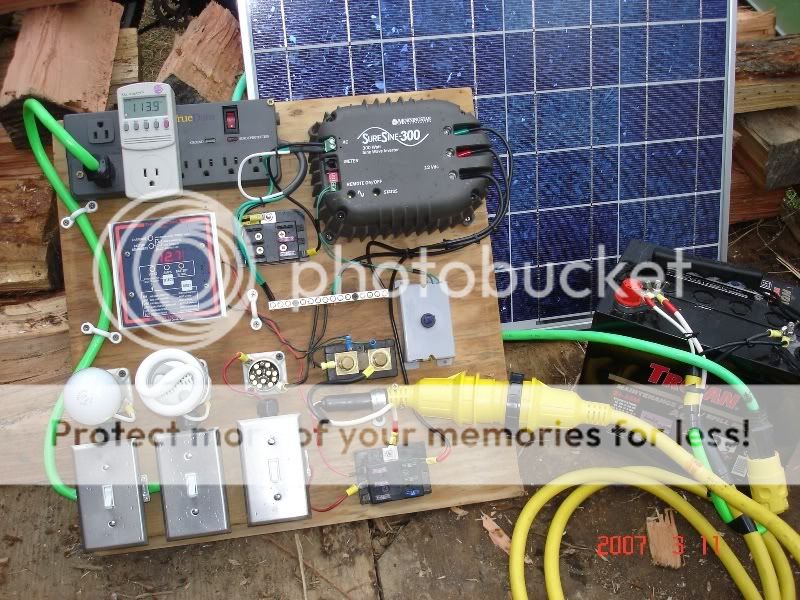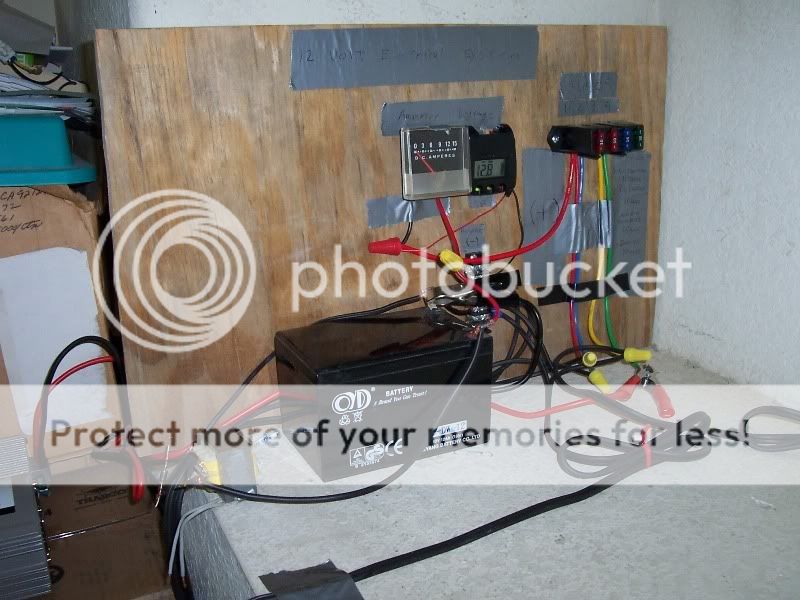Josey
Flashlight Enthusiast
Every year I give a couple talks on solar power at the local Homebuilder's Expo. I thought some of you would be interested in my solar-powered light demonstration board, which is a complete working solar system. When the Expo demonstration tents overloaded the electrical circuit, I was the only one with power.
A 50-watt Kyocera multicrystal solar panel fills a Trojan 80Ah AGM battery. The battery plugs into the light board. The LED you see is a 12V light, brighter when looking straight on than the 75-watt incandescent and 26-watt full-spectrum CFL., both of which are on an AC circuit that comes from a new 300-watt Morningstar pure sine wave inverter that can take a surge of 600 watts for 15 minutes. The Trimetric meter can read battery voltage or the amps being drawn by the lights or by any appliance I plug into the board.
I show people the brightness of the bulbs, and then I show them the amps being drawn. The incandescent uses about 7 amps. The CFL (which is much brighter) uses a little over 2 amps. And the LED, which is the brightest looking straight on (although not the brightest for total lumens) generally bounces between 0.0 and 0.1 amps. Just one hour of sun on my solar panels (one hour total sun, not one hour each day) can power my LED reading light for 4 hours every single night for a year. And the LED puts more light on the page I'm reading than the 75 watt incandescent when both are 2 feet from the page.
The Kill A Watt meter can read phantom power, which is the power most appliances use when turned off. It can read watts, amps, voltage, power factor, volt-amps and kilowatt-hours. My older model TV, if watched 4 hours a day, will use twice as much electricity during the 20 hours it is turned off as it does durning the 4 hours that I'm watching it. To get rid of phantom power, I plug my appliances into a surge protector (usually a Isobar, although I use a cheaper one on this board) and turn off the surge protector after I turn off the appliance.
The shunt (the brass thing in the middle of the board, is a very precise resistor which allows the Trimetric to read amps.
The problem I've found with 12V LEDs is that most are direct drive and designed for 12 volts. But a solar system runs from 12 volts to 15.5 volts, and the higher voltages push more amps through the LEDs shortening their lives by a lot. So now I use mostly AC LED lights, which are not quite as efficient but last a lot longer.
Here's the board with the lights turned off so you can see things better.

A 50-watt Kyocera multicrystal solar panel fills a Trojan 80Ah AGM battery. The battery plugs into the light board. The LED you see is a 12V light, brighter when looking straight on than the 75-watt incandescent and 26-watt full-spectrum CFL., both of which are on an AC circuit that comes from a new 300-watt Morningstar pure sine wave inverter that can take a surge of 600 watts for 15 minutes. The Trimetric meter can read battery voltage or the amps being drawn by the lights or by any appliance I plug into the board.
I show people the brightness of the bulbs, and then I show them the amps being drawn. The incandescent uses about 7 amps. The CFL (which is much brighter) uses a little over 2 amps. And the LED, which is the brightest looking straight on (although not the brightest for total lumens) generally bounces between 0.0 and 0.1 amps. Just one hour of sun on my solar panels (one hour total sun, not one hour each day) can power my LED reading light for 4 hours every single night for a year. And the LED puts more light on the page I'm reading than the 75 watt incandescent when both are 2 feet from the page.
The Kill A Watt meter can read phantom power, which is the power most appliances use when turned off. It can read watts, amps, voltage, power factor, volt-amps and kilowatt-hours. My older model TV, if watched 4 hours a day, will use twice as much electricity during the 20 hours it is turned off as it does durning the 4 hours that I'm watching it. To get rid of phantom power, I plug my appliances into a surge protector (usually a Isobar, although I use a cheaper one on this board) and turn off the surge protector after I turn off the appliance.
The shunt (the brass thing in the middle of the board, is a very precise resistor which allows the Trimetric to read amps.
The problem I've found with 12V LEDs is that most are direct drive and designed for 12 volts. But a solar system runs from 12 volts to 15.5 volts, and the higher voltages push more amps through the LEDs shortening their lives by a lot. So now I use mostly AC LED lights, which are not quite as efficient but last a lot longer.
Here's the board with the lights turned off so you can see things better.

Last edited:




